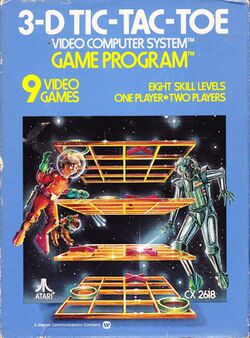(Atari Flashback converted to dedicated system) |
(migrate) |
||
| Line 1: | Line 1: | ||
{{Header Nav|game=3-D Tic-Tac-Toe | {{Header Nav|game=3-D Tic-Tac-Toe}} | ||
{{Game | {{Game | ||
|completion=0 | |||
|image=3D Tic-Tac-Toe box.jpg | |||
|title=3-D Tic-Tac-Toe | |title=3-D Tic-Tac-Toe | ||
|developer=[[Atari]] | |developer=[[Atari]] | ||
|publisher=[[Atari]] | |publisher=[[Atari]] | ||
| | |year=1978 | ||
|systems=[[Atari 8-bit]], [[Atari 2600]] | |||
|genre=[[Puzzle]] | |genre=[[Puzzle]] | ||
|modes=[[Single player]], [[multiplayer]] | |modes=[[Single player]], [[multiplayer]] | ||
}} | }} | ||
'''3-D Tic-Tac-Toe''' is a [[puzzle]] game released by [[Atari]] for the [[Atari 2600]] console and [[Atari 8-bit]] family in [[1980]]. In the late 2000s it was released with the [[Atari Flashback 2]]. | '''3-D Tic-Tac-Toe''' is a [[puzzle]] game released by [[Atari]] for the [[Atari 2600]] console and [[Atari 8-bit]] family in [[1980]]. In the late 2000s it was released with the [[Atari Flashback 2]]. | ||
The game is similar to the traditional game of tic-tac-toe, but is played on four 4x4 grids stacked vertically on top of each other; it is basically a computerized version of the board game Qubic (by Parker Brothers) using traditional tic-tac-toe notation and layout. | The game is similar to the traditional game of tic-tac-toe, but is played on four 4x4 grids stacked vertically on top of each other; it is basically a computerized version of the board game Qubic (by Parker Brothers) using traditional tic-tac-toe notation and layout. | ||
To win, a player must place four of their symbols on four squares that line up vertically, horizontally, or diagonally, on a single grid, or spaced evenly over all four grids. This creates a total of 76 possible ways to win, in comparison to eight possible ways to win on a standard 3 × 3 board. | To win, a player must place four of their symbols on four squares that line up vertically, horizontally, or diagonally, on a single grid, or spaced evenly over all four grids. This creates a total of 76 possible ways to win, in comparison to eight possible ways to win on a standard 3 × 3 board. The game has nine variations, it can be played by two players against each other, or one player can play against a built-in AI on one of eight different difficulty settings. The game uses the standard joystick controller. | ||
<gallery> | <gallery> | ||
File:3-D Tic-Tac-Toe Atari 2600 box back.jpg | File:3-D Tic-Tac-Toe Atari 2600 box back.jpg | ||
| Line 29: | Line 26: | ||
[[Category:Atari 8-bit]] | [[Category:Atari 8-bit]] | ||
[[Category:Atari 2600]] | [[Category:Atari 2600]] | ||
[[Category:Puzzle]] | [[Category:Puzzle]] | ||
[[Category:Single player]] | [[Category:Single player]] | ||
[[Category:Multiplayer]] | |||
Revision as of 04:14, 29 September 2021

| 3-D Tic-Tac-Toe | |
|---|---|
| Developer(s) | Atari |
| Publisher(s) | Atari |
| Year released | 1978 |
| System(s) | Atari 8-bit, Atari 2600 |
| Genre(s) | Puzzle |
|---|---|
| Modes | Single player, multiplayer |
3-D Tic-Tac-Toe is a puzzle game released by Atari for the Atari 2600 console and Atari 8-bit family in 1980. In the late 2000s it was released with the Atari Flashback 2.
The game is similar to the traditional game of tic-tac-toe, but is played on four 4x4 grids stacked vertically on top of each other; it is basically a computerized version of the board game Qubic (by Parker Brothers) using traditional tic-tac-toe notation and layout.
To win, a player must place four of their symbols on four squares that line up vertically, horizontally, or diagonally, on a single grid, or spaced evenly over all four grids. This creates a total of 76 possible ways to win, in comparison to eight possible ways to win on a standard 3 × 3 board. The game has nine variations, it can be played by two players against each other, or one player can play against a built-in AI on one of eight different difficulty settings. The game uses the standard joystick controller.
